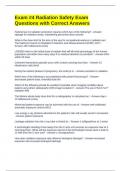-
1. Exam (elaborations) - 40 hr radiation safety exam questions and answers
-
2. Exam (elaborations) - 40hour radiation safety exam questions and answers
-
3. Exam (elaborations) - 143 radiation safety exam 1-143 questions with correct answers
-
4. Exam (elaborations) - Basic radiation safety exam questions and answers
-
5. Exam (elaborations) - California rvt exam study guide radiation safety questions and answers
-
6. Exam (elaborations) - Radiation protection (exam 3) ch - 10, 11 questions with correct answers
-
7. Exam (elaborations) - Radiation protection (exam 2) ch - 6, 7 questions with correct answers
-
8. Exam (elaborations) - Radiation health and safety exam questions with verified answers
-
9. Exam (elaborations) - Radiation health and safety exam questions with latest update
-
10. Exam (elaborations) - Radiation health and safety exam questions with correct answers
-
11. Exam (elaborations) - Oklahoma dental radiation protection and safety exam questions with complete solution...
-
12. Exam (elaborations) - Ndt radiation safety training exam questions and answers
-
13. Exam (elaborations) - Module 2 radiation safety exam questions and answers
-
14. Exam (elaborations) - Lesson 2 radiation safety exam questions and answers
-
15. Exam (elaborations) - Initial radiation safety training exam questions and answers
-
16. Exam (elaborations) - Hesi radiation health & safety practice exam questions with latest update
-
17. Exam (elaborations) - Hesi da practice test - radiation health & safety exam questions with latest update
-
18. Exam (elaborations) - Health physics radiation safety exam 1 (1-4) questions and answers
-
19. Exam (elaborations) - Exam 1 radiation safety chapters 1-3 questions with latest update
-
20. Exam (elaborations) - Exam #4 radiation safety exam questions with correct answers
-
21. Exam (elaborations) - Dental radiation safety exam questions with complete solutions
-
22. Exam (elaborations) - Dental radiation safety exam questions and answers
-
23. Exam (elaborations) - Dental radiation and safety exam study guide questions and answers
-
24. Exam (elaborations) - Ch 15 radiation safety (for rda exam) questions and answers
-
25. Exam (elaborations) - Dental radiation and safety exam study guide questions and answers
-
26. Exam (elaborations) - Radiation protection exam 3 questions and answers
-
27. Exam (elaborations) - Radiation protection exam questions with answers latest update
-
28. Exam (elaborations) - Radiation protection final exam- practice questions with correct answers latest updat...
-
29. Exam (elaborations) - Radiation protection test exam questions and answers latest update
-
30. Exam (elaborations) - Radiation protection unit 1 exam questions with latest update
-
31. Exam (elaborations) - Radiation safety (ammo 66) final exam questions with correct answers
-
32. Exam (elaborations) - Radiation safety and protection exam questions with latest update
-
33. Exam (elaborations) - Radiation safety certification exam questions and answers
-
34. Exam (elaborations) - Radiation safety exam #2 questions and answers
-
35. Exam (elaborations) - Radiation safety exam 1 review questions and answers
-
36. Exam (elaborations) - Radiation safety exam 4 questions with complete solutions
-
37. Exam (elaborations) - Radiation safety exam 5 3007 questions and answers
-
38. Exam (elaborations) - Radiation safety exam questions and answers complete solutions
-
39. Exam (elaborations) - Radiation safety exam questions and answers latest update
-
40. Exam (elaborations) - Radiation safety exam questions and answers
-
41. Exam (elaborations) - Radiation safety exam questions and answers
-
42. Exam (elaborations) - Radiation safety exam questions with verified answers
-
43. Exam (elaborations) - Radiation safety exam review questions and answers
-
44. Exam (elaborations) - Radiation safety exam study guide questions and answers
-
45. Exam (elaborations) - Radiation safety examination questions with complete solutions
-
46. Exam (elaborations) - Radiation safety final exam questions with complete solutions
-
47. Exam (elaborations) - Radiation safety final exam questions with verified answers
-
48. Exam (elaborations) - Radiation safety officer course cbt – exam questions with correct answers
-
49. Exam (elaborations) - Radiation safety quiz exam questions and answers
-
50. Exam (elaborations) - Radiation safety review and essentials program mock exam questions with correct answe...
-
51. Exam (elaborations) - Radiation safety scda given study guide questions and answers
-
52. Exam (elaborations) - Radiation safety state test (la) exam questions and answers latest update
-
53. Exam (elaborations) - Radiation safety test exam questions and answers
-
54. Exam (elaborations) - Radiation safety training exam questions and answers
-
55. Exam (elaborations) - Rda written exam - dental radiation safety questions and answers
-
56. Exam (elaborations) - Rhs exam radiation safety questions and answers
-
57. Exam (elaborations) - Rtbc safety exam radiation safety questions with latest update
-
58. Exam (elaborations) - Scda radiation safety exam questions with correct answers
-
59. Exam (elaborations) - Vcu dental radiation safety certification exam questions and answers
-
Show more





